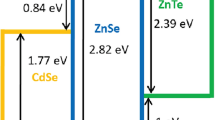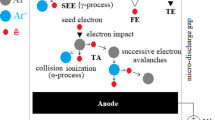Abstract
The maximum intensity of the electrostatic field used in the study of its influence on the properties of magnetoactive coordination compounds is limited by the breakdown phenomenon. The breakdown of the gas medium is developed, as a rule, in the region of location of the studied sample and results in its destruction. The determination of optimum intensities of the electrostatic field is very important for successful accomplishment. The breakdown voltage in argon, nitrogen, and sulfur hexafluoride is studied in a temperature range of 80–300 K. The theory of breakdown appearance in gases makes it possible to assume an increase in the breakdown voltage with a decrease in the temperature of the studied gas. The following data are obtained by measuring the breakdown voltage under atmospheric pressure in the gas media between the planar electrodes remote at 0.7 mm: for nitrogen with decreasing temperature from 300 to 80 K, the breakdown voltage averaged over several measurements increases from 2.8 kV (field intensity Е ≈ 40 kV/cm) to 5.6 kV (Е ≈ 80 kV/cm); for argon with decreasing temperature from 300 to 90 K, this value increases from 1.4 kV (20 kV/cm) to 2.2 kV (31 kV/cm); and for elegas in the temperature range from 300 to 210 K, the average breakdown voltage increases from 5 kV (71 kV/cm) to 7.9 kV (113 kV/cm).



Similar content being viewed by others
REFERENCES
Aisin, R.R., Belov, A.S., Belova, S.A., et al., Russ. J. Coord. Chem., 2019, vol. 46, p. 290. https://doi.org/10.31857/S0132344X20120014
Bousseksou, A., Molnar, G., Salmona, L., and Nicolazzia, W., Chem. Soc. Rev., 2011, vol. 40, p. 3313. https://doi.org/10.1039/C1CS15042A
Starikov, A.G., Starikova, A.A., Chegerev, M.G., and Minkin, V.I., Russ. J. Coord. Chem., 2019, vol. 45, p. 92. https://doi.org/10.1134/S0132344X19020087
Lanfranc de Panthou, F., Belorizky, E., Calemczuk, R., et al., J. Am. Chem. Soc., 1995, vol. 117, p. 11247. https://doi.org/10.1021/ja00150a023
Ovcharenko, V.I., Maryunina, K.Y., Fokin, S.V., et al., Russ. Chem. Bull., 2004, vol. 53, p. 2406. https://doi.org/10.1007/s11172-005-0136-4
Romanenko, G.V., Fokin, S.V., Chubakova, E.T., et al., J. Struct. Chem., 2022, vol. 63, no. 1, p. 87.
Bodnar, S.H., Caneschi, A., Dei, A., et al., Chem. Commun., 2001, p. 2150. https://doi.org/10.1039/B106192P
Evangelio, E. and Ruiz-Molina, D., Eur. J. Inorg. Chem., 2005, no. 15, p. 2957.
Lukov, V.V., Shcherbakov, I.N., Levchenkov, S.I., et al., Russ. J. Coord. Chem., 2019, vol. 45, p. 163. https://doi.org/10.1134/S0132344X1903006X
Meshcheryakova, I.N., Trofimova, O.Y., Druzhkov, N.O., et al., Russ. J. Coord. Chem., 2021, vol. 47, p. 307. https://doi.org/10.31857/S0132344X21050042
Minakova, O.V., Tumanov, S.V., Fedin, M.V., and Veber, S.L., Russ. J. Coord. Chem., 2020, vol. 46, p. 326. https://doi.org/10.31857/S0132344X20040040
Skanavi, G.I., Fizika dielektrikov (oblast' sil’nykh polei) (Physics of Dielectrics (Strong Field Region)), Moscow: FIZMATLIT, 1958.
Raizer, Yu.P., Fizika gazovogo razryada (Gas Discharge Physics), Moscow: Nauka, 1987
Gokhberg, B.M., Elektrichestvo, 1947, no. 3, p. 15.
Author information
Authors and Affiliations
Corresponding authors
Ethics declarations
The authors declare that they have no conflicts of interest.
Additional information
The authors congratulate Academician V.I. Ovcharenko on the occasion of his 70th jubilee
Translated by E. Yablonskaya
Rights and permissions
About this article
Cite this article
Borodulina, A.V., Minakova, O.V. & Veber, S.L. Breakdown Voltage in Argon, Nitrogen, and Sulfur Hexafluoride Gases As a Function of Temperature. Russ J Coord Chem 48, 452–455 (2022). https://doi.org/10.1134/S1070328422070028
Received:
Revised:
Accepted:
Published:
Issue Date:
DOI: https://doi.org/10.1134/S1070328422070028




